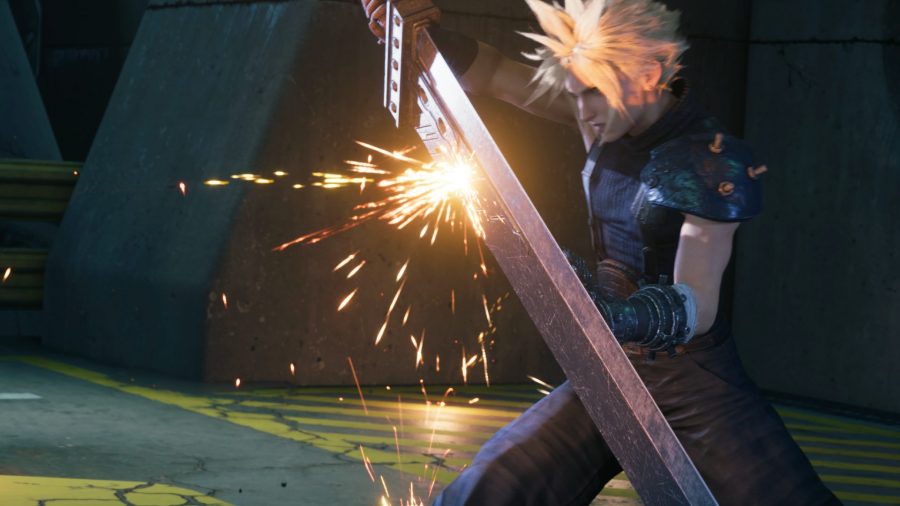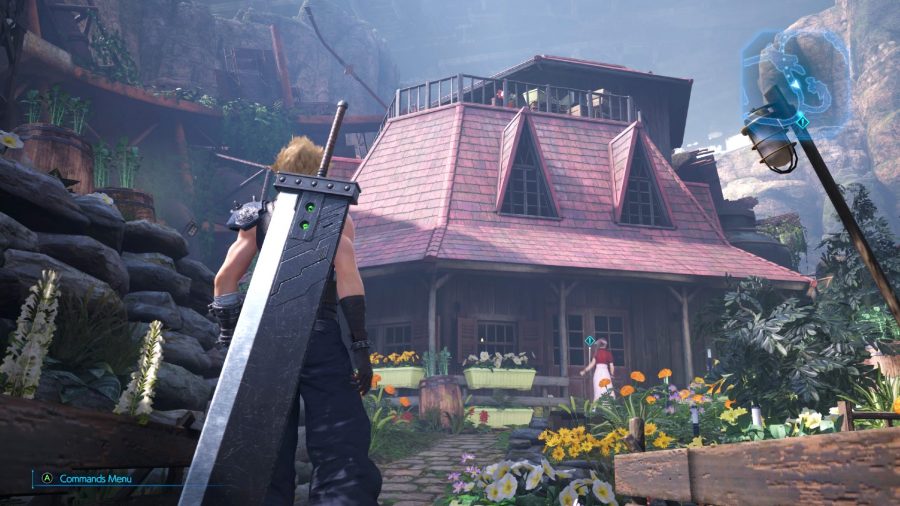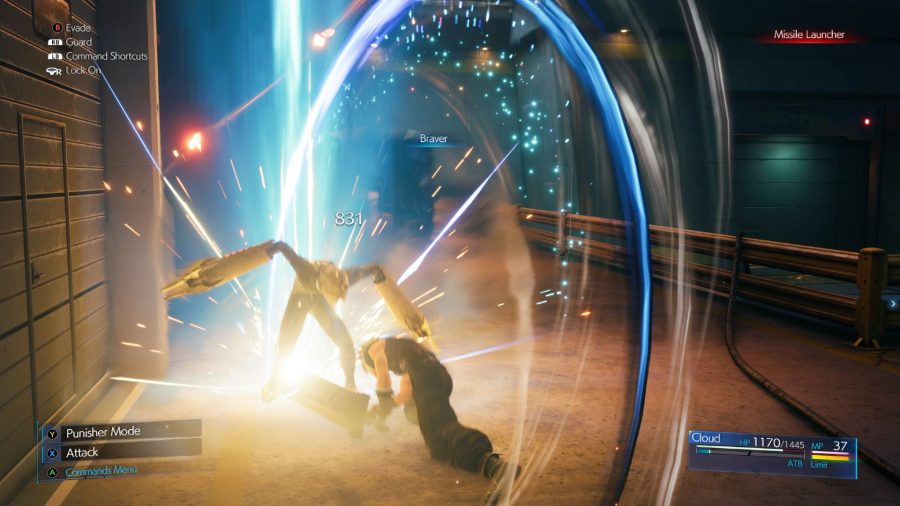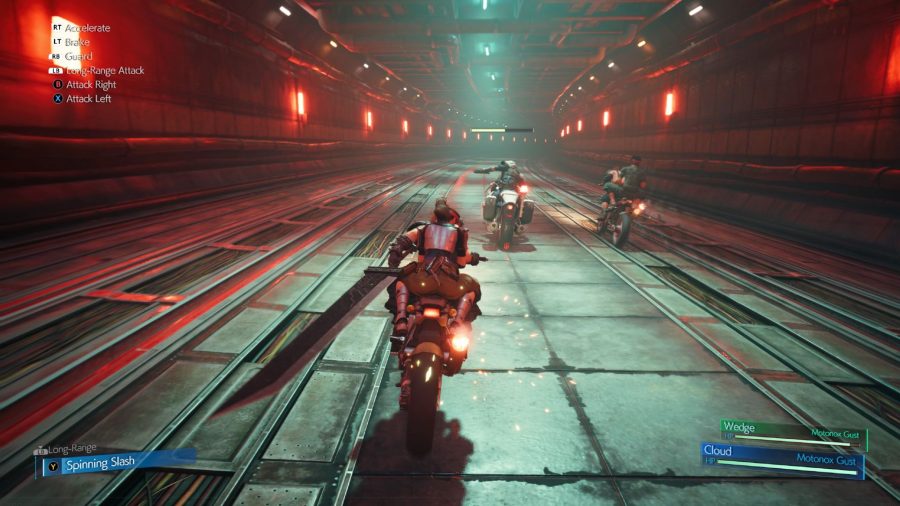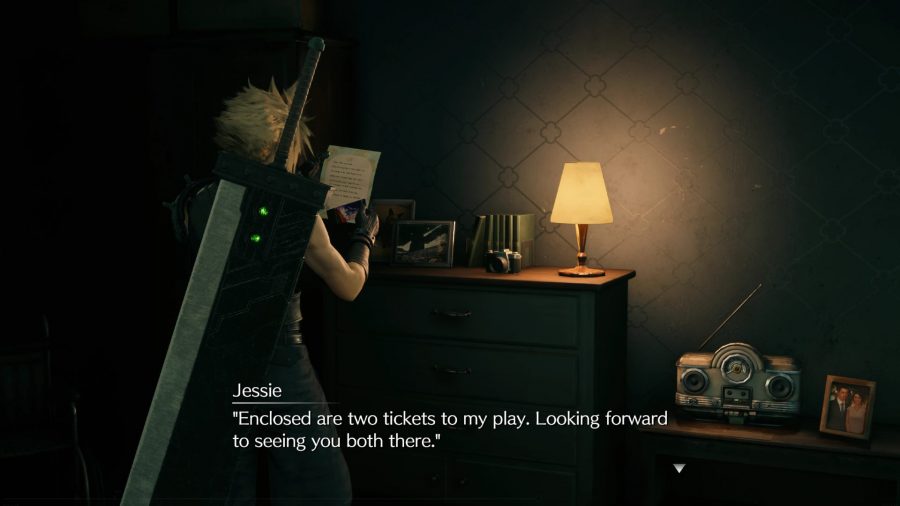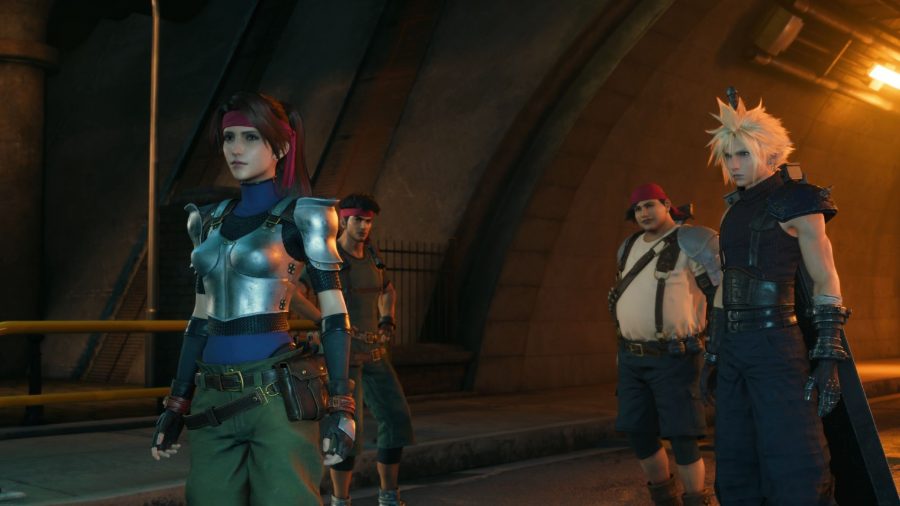Midgar is less a city and more a vast reactor network that people happen to live around. The curvature of pipes and chimneys that forms its silhouette looks nothing like New York, Paris, or Altissia. Streets wind their way in awkward lines around its structure, most dwellings simply propped against its foundations in a haphazard shanty town. It’s a giant wheel of heavy industry, all ungainly girders and exhausts around a central tower.
This is the first thing you see in Final Fantasy VII, realised in greatly more detail in Remake Intergrade. Even though Square Enix leaves nothing to chance with hours of opening cutscene exposition, if you skipped it all you’d still understand by the look of Midgar alone that this is an unhappy place. A place where corporate megalomania has gone unchecked for long enough to manifest itself physically, where Shinra doesn’t give a Gil for the denizens living in squalid conditions around its eight Mako reactors. You’d understand why a terrorist group called Avalanche has formed to take the energy conglomerate down.
What you wouldn’t understand, certainly without the benefit of a treasure trove of PlayStation 1 memories to frame this remake’s context, is why Cloud Strife has signed up. The young former SOLDIER mopes about with an otherwise passionate group of Avalanche activists, harrumphing at every juncture, stonewalling any attempt at camaraderie and still, somehow, proving utterly irresistible to every woman in Gaia. Apparently a sleeveless turtleneck and improbably coiffured hair go a long way, but what once came across as typical heroic stoicism seems churlish now upon second visit. It’s like saving the world with Christian Bale.
Not every element of this long, long-anticipated (especially on PC) remake stands on its own two feet without nostalgia propping it up, and the interplay between your sulky ex-SOLDIER protagonist and the rest of your party is the most striking reminder that it’s no longer 1997. It’s to Square Enix’s enormous credit that such moments are only brief, jarring grazes in 30 hours of reworked material, covering the first disc of Final Fantasy VII’s original release. Indeed, the very idea of 30 hours of linear, bespoke single-player content with such thought for pacing and adventure as this is enough to make you wish it was 1997 again.
It’s also to the studio’s credit that anything is recognisable at all, after the translation of a turn-based game that took place against largely pre-rendered backgrounds into a fully 3D real-time action-RPG. Even though the original models of Tifa, Barret, Wedge, Jessie, Biggs, and the rest of the gang were made from about five polygons, their intricately detailed Unreal Engine 4 counterparts look and feel right. Everyone is just the way you want them to be, and that’s taken shrewd creative licensing to achieve.
With so few tools it’s simply not possible to leverage the PC’s extra grunt to make the game look better than the PS5 version
It’s the enormous task of taking all those pre-rendered backgrounds – a Midgar held together with nostalgia and sticky tape in our childhood imaginations – and creating a compelling 3D space that really shows FF7RI’s dedication and love for the source material. Although it’s certainly not frame-by-frame accurate to the original’s events and settings, each location feels the way you’d want it to, like coming home after many years and realising your old house is much smaller than it seemed. Also it’s attached to a corporate machine that’s killing the planet.
So it almost seems against the spirit of the arrangement to delve into its graphics options and fiddle around with the parameters it uses to conjure that magic. But do so we must – it’s the PC gamer’s credo. And what a puzzling lack of graphics options there are here.
It’s running on Unreal Engine 4, and we know very well how tweakable that can be, but its settings menu only includes options for the resolution, texture res, shadow res, target frame rate, and the number of characters displayed. It’s a world away from the last Final Fantasy release on PC, the feature-rich FFXV, which pioneered Nvidia DLSS among a wide array of other texture and lighting options.
This remake has an eye for vistas
With so few tools at your disposal, it’s simply not possible to leverage the PC’s extra grunt to make the game look better than its PS5 counterpart. Only the 11-point characters displayed slider (which affects draw distances on NPC character models) seems to take the PC version beyond the console version, and hardly in a transformative way. Conspiracy theorists will have already formed some fairly strong opinions as to why that might be.
The texture and shadow resolutions can be dropped from high to low for a reasonable frame rate payout, but the game does most of the performance legwork using a dynamic resolution to hit your target frame rate. As discovered by Digital Foundry, this setting can’t be disabled without the use of mods. On the plus side, it meant I enjoyed a smooth 60fps experience using an i7 9700K, RTX 2080 TI and 16GB RAM at 4K with only occasional moments of smeared, visibly dropped resolution. It’s annoying not to be given that level of control over the PC version, though.
Nevertheless the visual overhaul here is constantly impressive. The Sector 5 slums bustle with just enough human activity to be convincing, and the markets propped up around its dusty streets catch your eye with their colour and detail. Sector 7, a comfortable suburb where Jessie’s parents and other Shinra employees live in relative luxury, feels at once soothing and sinister to walk around, its reassuringly normal houses backdropped by Mako braziers and the brutalist silhouettes of the Midgar hub. Aerith’s garden of flowerbeds encircling an impossibly cosy family home is spellbinding, and the interiors of the Mako reactors where Avalanche does its operations are sufficiently clinical.
It has an eye for vistas, this remake. Chapter 6 uses the verticality of Shinra’s sun lamps to sell you the size of the city below and the sprawl of the industrial platforms up on high. A couple of hours later, jumping between rooftops in the city outskirts with Aerith, you’re treated to a more pastoral glimpse of an otherwise grimy city.
It seems almost impossible to conceive that Final Fantasy VII could survive the transition from turn-based to real-time combat without a sense of compromise hanging over your encounters with Riot Troopers, Hedgehog Pies, Monodrives, and Turks. This is the turn-based combat game for a generation of gamers, and the yardstick for all subsequent turn-based RPG games thereafter. The idea of playing it using a combat system adapted from Final Fantasy XIII is the stuff of drenched bedsheets and night terrors for purists.
And yet somehow, like a sword whose dimensions exceed those of its wielder, it works. There’s a mix of real-time hack-and-slash, and abilities and spells that pop off in a semi-paused state at the heart of the fight here, and it works similarly to FFXV’s scraps. While the latter fostered an obsession with cooking delicious meals before every encounter though, the original’s flavour bubbles up to the surface in the form of materia.
where this remake soars is in delivering a sense of adventure
Leveling and combining these perk-giving orbs was crucial to success in the original, with the absolute optimum combinations for each character the topic of much playground bickering in 1997. It feels like more than fan service that they’re so central to fights, particularly boss encounters, here. Just as before, the game goads you into going the extra mile for a materia orb that lies just out of reach, knowing you can’t just plough on without knowing what outlandishly powerful effects it might bestow on your party.
Materia’s effects on spell and weapon damage, HP, MP, resistance to status effects, and more give you something to be thinking about in every encounter beyond bashing X. And bashing X will get you far in easy mode – only boss fights really demand you dig into the menus. On normal and above – there’s a ’classic’ variation of each that automates default combat inputs – it’s necessary to concern yourself with materia’s optimal deployment.
Together with weapon leveling, magic attacks, and limit breaks that build up after taking damage or staggering enemies – not to mention the stagger system itself – it can feel a bit overwhelming for the first few hours. To its credit, FF7RI lets you get away with basic combat inputs during the opening chapters on any difficulty, and invites you to explore its combat systems on a deeper level at your own pace. By the time you’re launching a second assault on a Mako reactor, you know to stagger enemies with lots of hits in a short spell to weaken them, and you’ve probably started tailoring each party member to a specific role.
Read more: FF7 is important because it lets its men be vulnerable
What the remake doesn’t carry over is the sheer tension of the original’s turn-based attacks. Thinking three turns ahead, you’d calculate exactly how much damage you could withstand and who to heal in order to get to the crucial turn when an ability could finish a boss. Here, on the fly, there isn’t time to build that tension, even during boss fights that take ten minutes or more. It’s tactical, it’s complex, but it’s not the anecdote generator its source material proved to be.
How easy it is to make peace with any small complaints you might have about combat, though. Because where this remake soars, just like the ‘97 game, is in delivering a sense of adventure. We’re parched for adventures, proper ones, in the wake of the games as a service model. More than any other nostalgic itch this remake scratches, it’s the carefully crafted epic story that really gets under your skin. The pacing seems so unusual by modern standards, beginning right in the thick of the action and then wandering around in scene-setting downtime for hours afterwards before another chance to make things explode.
You might even be tempted to skip the odd cutscene of Barret grimacing or Tifa explaining the day-to-day running of her bar. But you’d be missing out, because all of the extraneous details and incidental conversations really build up over time and work their way into your consciousness.
What the remake doesn’t carry over is the sheer tension of the original’s turn-based attacks
During the first Mako reactor mission you couldn’t care less who these miscreants are who employ you and why they want to blow up a piece of Midgar. By the second, they’re like your own family, and Shinra’s destruction is an imperative you feel at a molecular level in your blood.
That pacing’s thrown off by the commercial and production reality of Final Fantasy 7 Remake’s episodic model. It was never going to be feasible for the entire saga to materialise with one purchase and 100+ hours of triple-A solo content, but by going all Peter Jackson and spreading the story slightly thin across – well, who knows how many subsequent releases – it leaves major characters Aerith and Sephiroth feeling slightly tangential for the entire first half of this entry. Maybe that’s a deliberate creative decision, but it doesn’t feel like it.
In fairness, the Yuffie-focused Intermission content is substantial and adds several hours to the overall playtime here, but it feels disconnected from the central nostalgic appeal.
It’s not quite the dream version of our dream game. Not many Final Fantasy 7 fans would have preferred a multi-release treatment, or a PC port that’s this barebones. But all of them would melt at the sight of Cloud and his buster sword, strolling through the slums and up to his room in real time, Midgar’s turquoise Mako chimneys casting a cold light over an otherwise warm twilight.
{“schema”:{“page”:{“content”:{“headline”:”Final Fantasy 7 Remake PC review – Cloud nine”,”type”:”review”,”hardware”:”WD_BLACK SN750 500GB High-Performance NVMe Internal Gaming SSD”,”category”:”final-fantasy-7-remake”},”user”:{“loginstatus”:false},”game”:{“publisher”:””,”genre”:””,”title”:”Final Fantasy 7: Remake”,”genres”:[]}}}}


